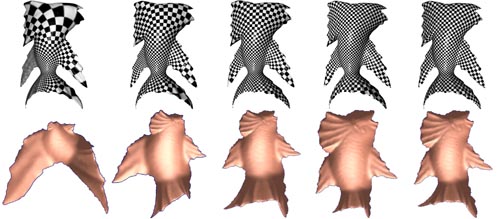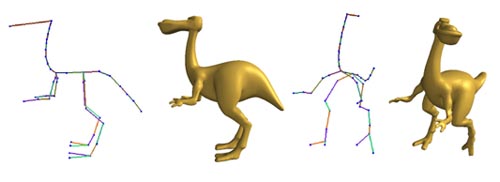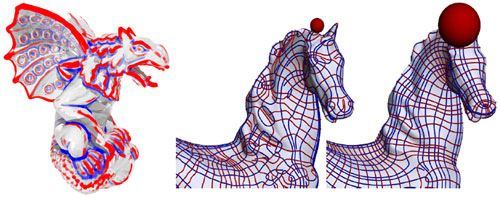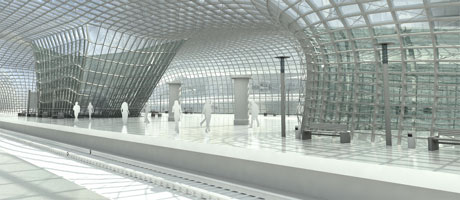| Yong-Liang Yang (杨永亮) | visit my current homepage here |
|
I recieved the Ph.D from Dept. of Computer Science and Technology, Tsinghua University, Beijing, China. I am currently working as a Research Scientist in Geometric Modeling and Scientific Visualization Center, King Abdullah University of Science and Technology, KSA. |
|
Contact Info
Lab: Room 2110, Level 2, Building 1, KAUST, Thuwal, Jeddah, KSA (23955-6900)
Tel: +966-2-8080262
Email: yongliang.yang@kaust.edu.sa
Education
| 09/2000-07/2004 | Dept. of Computer Science and Technology, Tsinghua University | Bachelor Degree | |
| 09/2004-07/2006 | Dept. of Computer Science and Technology, Tsinghua University | Master Degree | |
| 09/2006-09/2009 | Dept. of Computer Science and Technology, Tsinghua University | Ph.D Degree |
Work
| 9/2011-presnt | Geometric Modeling and Scientific Visulization Center, KAUST | Research Scientist | |
| 10/2009-8/2011 | Geometric Modeling and Scientific Visulization Center, KAUST | Post-doctorial Fellow |
Visiting Experience
10/2008-04/2009 Center for Visual Computing, State University of New York at Stony Brook, Stony Brook, NY 11790, USA.
7/2005-10/2005 Geometric Modeling and Industrial Geometry Group, Vienna University of Technology, A-1040 Wien, Austria.
Research Area
- Computer Graphics
- Geometry Processing
- Geometric Design
 |
 |
|
 |
||
 |
 |
Generalized Discrete Ricci Flow
Computer Graphics Forum, Special issue of Pacific Graphics 2009, Vol. 28, No. 7, 2005-2014.

Yong-Liang Yang, Ren Guo, Feng Luo, Shi-Min Hu, and Xianfeng Gu
Surface Ricci flow is a powerful tool to design Riemannian metrics by user defined curvatures. Discrete surface Ricci flow has been broadly applied for surface parameterization, shape analysis, and computational topology. Conventional discrete Ricci flow has limitations. For meshes with low quality triangulations, if high conformality is required, the flow may get stuck at the local optimum of the Ricci energy. If convergence to the global optimum is enforced, the conformality may be sacrificed. This work introduces a novel method to generalize the traditional discrete Ricci flow. The generalized Ricci flow is more flexible, more robust and conformal for meshes with low quality triangulations. Conventional method is based on circle packing, which requires two circles on an edge intersect each other at an acute angle. Generalized method allows the two circles either intersect or separate from each other. This greatly improves the flexibility and robustness of the method. Furthermore, the generalized Ricci flow preserves the convexity of the Ricci energy, this ensures the uniqueness of the global optimum. Therefore the algorithm won't get stuck at the local optimum. Generalized discrete Ricci flow algorithms are explained in details for triangle meshes with both Euclidean and hyperbolic background geometries. Its advantages are demonstrated by theoretic proofs and practical applications in graphics, especially surface parameterization.
 |
 |
|
 |
||
 |
 |
Optimal Surface Parameterization Using Inverse Curvature Map
IEEE Transaction on Visualization and Computer Graphics, 2008, Vol. 14, No. 5, Septmber/Octber, 1054-1066.

Yong-Liang Yang, Junho Kim, Feng Luo, Shi-Min Hu, and Xianfeng Gu
Mesh parameterization is a fundamental technique in computer graphics. The major goals during mesh parameterization are to minimize both the angle distortion and the area distortion. Angle distortion can be eliminated by use of conformal mapping, in principle. Our paper focuses on solving the problem of finding the best discrete conformal mapping that also minimizes area distortion. Major theoretical results and practical algorithms are presented for optimal parameterization based on the inverse curvature map. Comparisons are conducted with existing methods and using different energies. Novel parameterization applications are also introduced. The theoretical framework of the inverse curvature map can be applied to further study discrete conformal mappings.
 |
 |
|
 |
||
 |
 |
Shape Deformation using a Skeleton to Drive Simplex Transformations
IEEE Transaction on Visualization and Computer Graphics, 2008, Vol. 14, No. 3, May/June, 693-706

Han-Bing Yan, Shi-Min Hu, Ralph R Martin, and Yong-Liang Yang
The preliminary version of this work has been presented on CGI 2006
This paper presents a skeleton-based method for deforming meshes (the skeleton need not be the medial axis). The significant difference from previous skeleton-based methods is that the latter use the skeleton to control movement of vertices whereas we use it to control the simplices defining the model. By doing so, errors that occur near joints in other methods can be spread over the whole mesh, via an optimization process, resulting in smooth transitions near joints of the skeleton. By controlling simplices, our method has the additional advantage that no vertex weights need be defined on the bones, which is a tedious requirement in previous skeleton-based methods. Furthermore, by incorporating the translation vector in our optimisation, unlike other methods, we do not need to fix an arbitrary vertex, and the deformed mesh moves with the deformed skeleton. Our method can also easily be used to control deformation by moving a few chosen line segments, rather than a skeleton.
 |
 |
|
 |
||
 |
 |
Principal curvatures from the integral invariant viewpoint
Computer Aided Geometric Design, vol. 24, pp. 428-442, 2007.

Helmut Pottmann, Johannes Wallner, Yong-Liang Yang, Yu-Kun Lai and Shi-Min Hu
The extraction of curvature information for surfaces is a basic problem of Geometry Processing. Recently an integral invariant solution of this problem was presented, which is based on principal component analysis of local neighbourhoods defined by kernel balls of various sizes. It is not only robust to noise, but also adjusts to the level of detail required. In the present paper we show an asymptotic analysis of the moments of inertia and the principal directions which are used in this approach. We also address implementation and, briefly, robustness issues and applications.
 |
 |
|
 |
||
 |
 |
Robust Principal Curvatures on Multiple Scales
Eurographics Symposium on Geometry Processing, pp. 223-226, 2006. 
Yong-Liang Yang , Yu-Kun Lai, Shi-Min Hu and Helmut Pottmann
Geometry processing algorithms often require the robust extraction of curvature information. We propose to achieve this with principal component analysis (PCA) of local neighborhoods, defined via spherical kernels centered on the given surface F. Intersection of a kernel ball Br or its boundary sphere Sr with the volume bounded by F leads to the so-called ball and sphere neighborhoods. Information obtained by PCA of these neighborhoods turns out to be more robust than PCA of the patch neighborhood Br \F previously used. The relation of the quantities computed by PCA with the principal curvatures of F is revealed by an asymptotic analysis as the kernel radius r tends to zero. This also allows us to define principal curvatures “at scale r” in a way which is consistent with the classical setting. The advantages of the new approach are discussed in a comparison with results obtained by normal cycles and local fitting; whereas the former method somewhat lacks in robustness, the latter does not achieve a consistent behavior at features on coarse scales. As to applications, we address computing principal curves and feature extraction on multiple scales.
 |  | |
 |
||
 |  |
Geometric Modeling with Conical Meshes and Developable Surfaces
ACM Transactions on Graphics, Vol. 25 , No. 3, 681-689. (ACM SIGGRAPH 2006)

Yang Liu, Helmut Pottmann, Johannes Wallner, Yong-Liang Yang and Wenping Wang
In architectural freeform design, the relation between shape and fabrication poses new challenges and requires more sophistication from the underlying geometry. The new concept of conical meshes satisfies central requirements for this application: They are quadrilateral meshes with planar faces, and therefore particularly suitable for the design of freeform glass structures. Moreover, they possess a natural offsetting operation and provide a support structure orthogonal to the mesh. Being a discrete analogue of the network of principal curvature lines, they represent fundamental shape characteristics. We show how to optimize a quad mesh such that its faces become planar, or the mesh becomes even conical. Combining this perturbation with subdivision yields a powerful new modeling tool for all types of quad meshes with planar faces, making subdivision attractive for architecture design and providing an elegant way of modeling developable surfaces.
 |  | |
 |
||
 |  |
Geometry and Convergence Analysis of Algorithms for Registration of 3D Shapes
Geometry and convergence analysis of algorithms for registration of 3D shapes, International Journal of Computer Vision, 2006, Vol. 67, No. 3, 277-296.

Helmut Pottmann, Qi-Xing Huang, Yong-Liang Yang and Shi-Min Hu
The computation of a rigid body transformation which optimally aligns a set of measurement points with a surface and related registration problems are studied from the viewpoint of geometry and optimization.We provide a convergence analysis for widely used registration algorithms such as ICP, using either closest points (Besl and McKay [2]) or tangent planes at closest points (Chen and Medioni [4]), and for a recently developed approach based on quadratic approximants of the squared distance function [24]. ICP based on closest points exhibits local linear convergence only. Its counterpart which minimizes squared distances to the tangent planes at closest points is a Gauss-Newton iteration; it achieves local quadratic convergence for a zero residual problem and { if enhanced by regularization and step size control { comes close to quadratic convergence in many realistic scenarios. Quadratically convergent algorithms are based on the approach in [24]. The theoretical results are supported by a number of experiments; there, we also compare the algorithms with respect to global convergence behavior, stability and running time.
Prizes and Honors Top
Scholarships
- Second-Class Scholarship of Excellent Students in Tsinghua Univ. 2003.
- Second-Class Scholarship of Excellent Students in Tsinghua Univ. 2002.
- Second-Class Scholarship of Excellent Students in Tsinghua Univ. 2001.
- First-Class Scholarship of Excellent Students in Tsinghua Univ. 2000.
Prizes
- First Prize of Student Research Training (SRT) in Tsinghua University. 2004
Honors
- Excellet Graduate of Tsinghua University, 2004.
- Excellent Bachelor Thesis, Tsinghua University, 2004.
